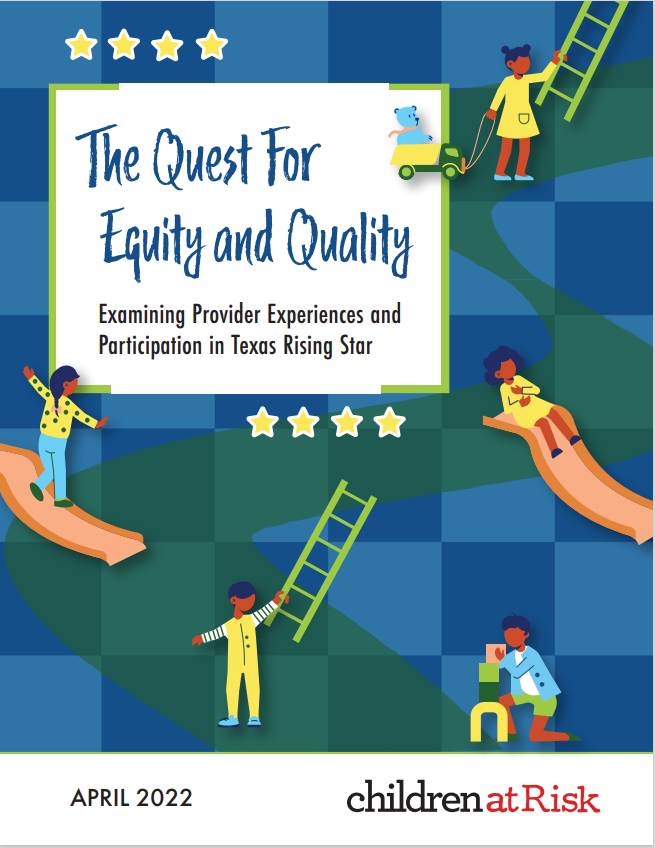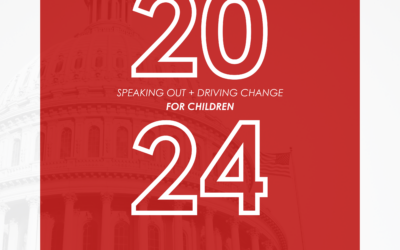Exposure to high-quality child care is the foundation for a child’s academic and social-emotional success, especially for children from low-income families. Increasing access to subsidized child care is one of the many strategies used to provide affordable early education to children from low-income families. However, increasing access alone is not enough when it comes to early learning. Children need to be in high-quality care to reap the many benefits.
In the report, The Quest for Equity and Quality, CHILDREN AT RISK examines the experiences of early childhood education providers with TRS through a race equity lens. The report highlights the experiences of providers of color to understand potential race equity barriers preventing providers of color from being certified with TRS. Specifically, CHILDREN AT RISK seeks to understand the motivating factors for providers who choose to participate in TRS and those who do not by asking the following questions:
- Why are Early Childhood Education providers choosing not to participate in TRS?
- Why are providers of color not participating?
- Why are White providers not participating?
- Why are Early Childhood Education providers choosing to participate in TRS?
- Why are providers of color participating?
- Why are White providers participating?
CHILDREN AT RISK in partnership with Prairie View A&M University and the University of Houston conducted a Racial Equity Workforce Survey and held focus groups on TRS participation and racial equity to gain insight on the current Texas landscape. While our research sought to uncover the implications race had on TRS participation, the conversations centered around equitable access to supports and resources providers needed to be successful. In the report, we offer recommendations and policy solutions to streamline TRS enrollment and participation and create a high-quality child care environment for Texas children. There is a need to have continued discussions that allow for deeper conversations about race as an underlying factor in providing equitable access to ECE in Texas.
MORE LIKE THIS
2024 Annual Report
Dear Friends and Advocates, At CHILDREN AT RISK, we believe that every child deserves a fair shot at success—and we know that it takes all of us to make that happen. Whether you’re a policymaker, educator, donor, volunteer, or advocate, your...
Connecting Across the Lone Star State: Reflections from CHILDREN AT RISK’s Spring 2025 Texas Tour
This spring, CHILDREN AT RISK’s early childhood team had the incredible opportunity to connect with our early learning family across Texas! While virtual tours may not physically transport us to the stunning beauty of an East Texas wildflower patch...
Texas Child Care Honor Roll
Media Contacts: Morgan Gerri, 832.600.9354 Rashena Franklin 713.301.4577 Research shows that 90% of brain development occurs in the first five years of a child’s life. This period is foundational—what children learn, or don’t learn, during...
Access to High-Quality Child Care is Scarce 2025 Analysis: Texas Child Care Deserts
Access to High-Quality Child Care is Scarce April 25, 2025 | C@R Blog, Early Childhood Education, Research Written by Kim Kofron, Senior Director of Education, and Jenn Meier, Associate Director of the Center for Social Measurement &...
Partners Advocate to Fund Child Care in the 89th Texas Legislative Session
Texas Association for the Education of Young Children (TXAEYC) and CHILDREN AT RISK partnered to present a legislative briefing and rally that urged lawmakers to #FundChildCare in the 89th Legislative Session. On March 6, 2025, state leaders, child...
Advocating in Support of SB 599/HB 4127
Kim Kofron, Senior Director of Education with CHILDREN AT RISK, testifies in support of SB 599/ HB 4127 during the March 11, 2025 Texas Senate Health and Human Services Committee Hearing. As the name implies, family home child care is simply an...




